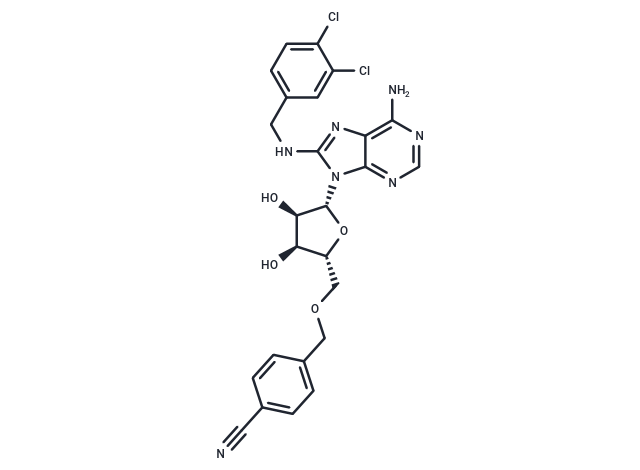Shopping Cart
Remove All Your shopping cart is currently empty
Your shopping cart is currently empty
VER-155008 is a potent Hsp70 family inhibitor with IC50 of 0.5 μM, 2.6 μM, and 2.6 μM in cell-free assays for HSP70, HSC70, and GRP78, respectively, >100-fold selectivity over HSP90.

| Pack Size | Price | USA Warehouse | Global Warehouse | Quantity |
|---|---|---|---|---|
| 2 mg | $39 | In Stock | In Stock | |
| 5 mg | $63 | In Stock | In Stock | |
| 10 mg | $85 | In Stock | In Stock | |
| 25 mg | $166 | In Stock | In Stock | |
| 50 mg | $297 | In Stock | In Stock | |
| 100 mg | $492 | In Stock | In Stock | |
| 200 mg | $688 | - | In Stock | |
| 1 mL x 10 mM (in DMSO) | $77 | In Stock | In Stock |
| Description | VER-155008 is a potent Hsp70 family inhibitor with IC50 of 0.5 μM, 2.6 μM, and 2.6 μM in cell-free assays for HSP70, HSC70, and GRP78, respectively, >100-fold selectivity over HSP90. |
| Targets&IC50 | HSC70:2.6 μM, GRP78:2.6 μM, HSP70:0.5 μM |
| In vitro | VER-155008 inhibits the proliferation of human breast and colon cancer cell lines BT474, MB-468, HCT116, and HT29 with GI50s in the range 5.3-14.4 μM, and induces Hsp90 client protein degradation in both HCT116 and BT474 cells.[1] In the 8505C and FRO cells, VER-155008 reduces the cell viability and elevates the percentage of dead cells in a time- and dose- dependent manner.[2] VER-155008 causes a dose-dependent inhibition of cytokine-dependent AML cell proliferation.[3] VER-155008?shows an effective inhibition of cell proliferation in A549 and H1975 cells. [4] |
| In vivo | In HCT116 tumor bearing mice, VER-155008 (25 or 40 mg/kg, i.v.) demonstrates rapid metabolism and clearance, along with tumor levels below the predicted pharmacologically active level.[1] |
| Kinase Assay | Hsc70, Hsp70 and Grp78 ?uorescence polarisation (FP) assay: The FP assay for Hsp70 is conducted in aqueous buffer consisting of 100 mM Tris pH 7.4, 150 mM KCl and 5 mM CaCl2, in a final assay volume of 100 μl, using 96 well black polystyrene high bind plates with a Fusion plate reader. N6-(6-amino)hexyl-ATP-5-FAM and the in-house protein preparation of GST-HSP70 3-382 have final concentrations in the assay of 20 nM and 400 nM, respectively. Compounds are tested as 10-point IC50s, with a final DMSO concentration of 5%. Assay mixtures are incubated for 3 h prior to reading on the Fusion (ex 485 nm; em 535 nm). The data is fitted using a 4 parameter logistical data model by XLFit 4. The FP assay for Hsc70 and Grp78 is carried out as described for Hsp70 using the same N6 -(6-amino)hexyl-ATP-5-FAM as the FP probe with the following modi?cations. For Hsc70, the protein and probe concentrations are 0.3 μM and 20 nM, respectively with a 30 min incubation at 22℃ while for Grp78, the protein and probe concentrations are 2 μM and 10 nM, respectively with a 2 h incubation at 22℃. The KD for the FAM-ATP probe was 0.24 μM for Hsc70 and 2 μM for Grp78. |
| Cell Research | All cell lines are grown in DMEM/10% FCS with GlutaMAX-I in a humidified atmosphere of 5% CO2 in air. Cell proliferation is determined using the sulforhodamine B (SRB) assay.(Only for Reference) |
| Synonyms | VER155008 |
| Molecular Weight | 556.4 |
| Formula | C25H23Cl2N7O4 |
| Cas No. | 1134156-31-2 |
| Smiles | Nc1ncnc2n([C@@H]3O[C@H](COCc4ccc(cc4)C#N)[C@@H](O)[C@H]3O)c(NCc3ccc(Cl)c(Cl)c3)nc12 |
| Relative Density. | 1.63 g/cm3 |
| Storage | Powder: -20°C for 3 years | In solvent: -80°C for 1 year | Shipping with blue ice/Shipping at ambient temperature. | |||||||||||||||||||||||||||||||||||
| Solubility Information | H2O: < 1 mg/mL (insoluble) DMSO: 79.17 mg/mL (142.29 mM), Sonication is recommended. | |||||||||||||||||||||||||||||||||||
| In Vivo Formulation | 10% DMSO+40% PEG300+5% Tween 80+45% Saline: 2 mg/mL (3.59 mM), Sonication is recommended. Please add the solvents sequentially, clarifying the solution as much as possible before adding the next one. Dissolve by heating and/or sonication if necessary. Working solution is recommended to be prepared and used immediately. The formulation provided above is for reference purposes only. In vivo formulations may vary and should be modified based on specific experimental conditions. | |||||||||||||||||||||||||||||||||||
Solution Preparation Table | ||||||||||||||||||||||||||||||||||||
DMSO
| ||||||||||||||||||||||||||||||||||||
| Size | Quantity | Unit Price | Amount | Operation |
|---|

Copyright © 2015-2026 TargetMol Chemicals Inc. All Rights Reserved.